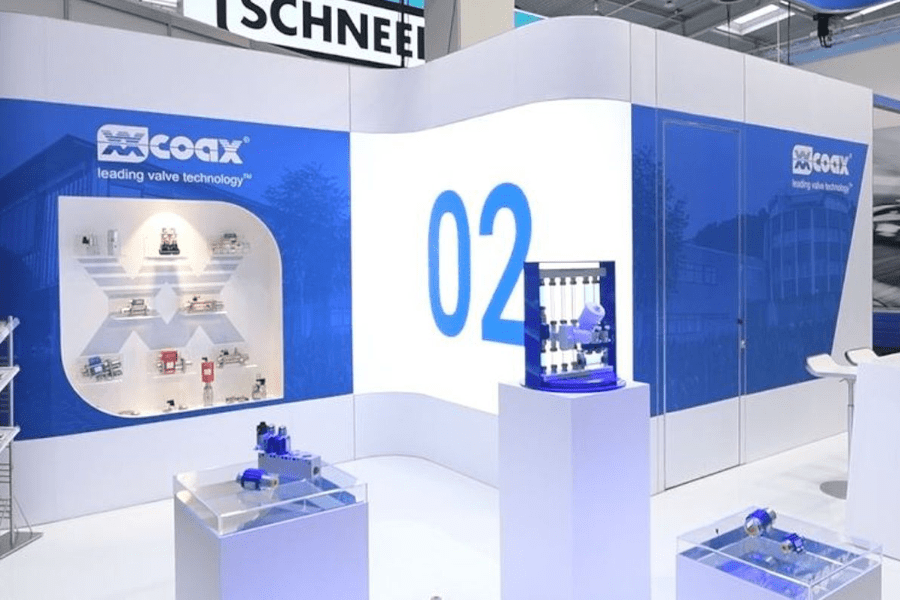Sustainable innovations in exhibition stand construction
Sustainable solutions are becoming increasingly important in modern trade fair construction. Companies, exhibitors and organizers are increasingly...

Digitalisation is a major topic in our society. It is virtually omnipresent and does not stop at any industry. It also has to be addressed in the exhibition stand construction sector.
Especially when it comes to graphic realisation, there are now new gimmicks and ways of attracting visitors' attention to your exhibition stand. Whereas years ago it was still foil plots, plate prints and even textile graphics, digital graphics are being used on more and more stands.
The production of textile printing is at an all-time high. This year, HP, one of the global players in large-format digital exhibition printing, launched its first dye-sublimation printer on the market. The fact that a company like HP, which is otherwise known for its own latex inks, is now also involved in dye-sublimation printing. This shows that dye-sublimation is still a maj
What used to be difficult to fit into a Sprinter van can now be transported by car, as the textile graphics can be folded. An exciting point when a graphic urgently needs to be couriered to the trade fair. The graphics can theoretically have been produced over several metres. The size is far less restricted than it was in the mid-2000s. Another plus is the comparatively simple application. Textile graphics are usually made up with piping and stretched into the appropriate frame. This can be done with virtually no tools, without the need for professional craftsmen. Conversely, this means that the graphic can be quickly assembled and disassembled. As we all know, time is money and is particularly relevant in the hustle and bustle of a trade fair. It is not uncommon for a graphic to break during assembly or for a spelling mistake to be discovered. After the trade fair, the material can also be wonderfully stored, as little space is required here too.

These are all helpful advantages that provide support for both customers and stand builders. However, as already mentioned at the beginning, digitalisation does not stop at anything. There are more and more exhibition stands that work with LED panels. These even top the advantages of textile graphics. When realised with LED video technology, nothing can get dirty or be installed incorrectly. In addition, there are no transport or storage costs for the graphics.
The content can be sent by stick or, depending on the file size, by e-mail or link. This is a big plus if you decide to change a graphic at short notice or if a graphic has been destroyed during assembly. Even simple content can generate a lot of attention at the trade fair stand. It doesn't matter whether the LED construction is only used selectively or across the entire exhibition stand. Or whether it should be straight or curved. There are virtually no limits to creativity here. This applies to both the structure and the graphic realisation. The technology is also used in many stadiums. Here, the display changes within a few seconds.

However, there are also a few things to consider and stumbling blocks with LED video walls. It is often easier to design and create print data than content or even a video. Although you can work with existing video, the format also plays an important role here. If you opt for special formats, there will probably be cuts in the image reproduction and not everything can be displayed in full. It also makes little sense in terms of costs to produce a video just for a trade fair stand that will never be used again. You invest considerably more time here if you don't already have content that can be modified.
Generally speaking, investing in LED video technology is not a cheap endeavour. Often, savings are made on the controller that is needed to play the content. However, this can lead to problems during playback. In the worst-case scenario, you have expensive technology at the trade fair, but it doesn't work because there are power or playback problems. Furthermore, the resolution of LED video walls is not yet comparable with HD or higher resolution. As with low-resolution print products, you have to plan for a viewing distance of 2 to 3 metres. This is of course difficult to plan for small exhibition stands. So there are a few points to bear in mind. This is also necessary given the current costs for LED video technology. These are comparatively higher than the simple frame profile with textile graphics or the pop-up display with counter.
So there are a few things you should consider in advance. It is important that you have someone on hand who can handle this technology. You also need content that can be ideally integrated. The technology itself is not yet fully developed. There is still room for improvement, especially in terms of resolution. On the other hand, you can ideally showcase your trade fair stand and attract the attention of visitors.
If you take this idea a step further, you can even change the content at short notice, so that the setting and the entire design change in a matter of seconds. Of course, this is not possible with static graphics. Nevertheless, they are still used more frequently in exhibition stand construction. There is simply more expertise here. However, real innovations are also becoming fewer and fewer, so there will probably be more and more LED video exhibition stands in the coming years.

Sustainable solutions are becoming increasingly important in modern trade fair construction. Companies, exhibitors and organizers are increasingly...

Flexibility for every occasion The trade fair industry has changed dramatically in recent years, and not without reason. Companies are faced with the...

We all know them: terminals in shopping centres, restaurants or at the airport for placing orders or making bookings. For the display of targeted,...